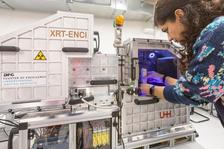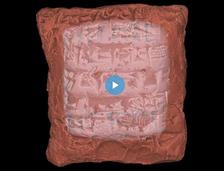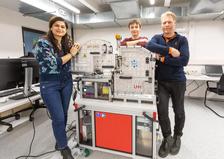Samaneh Ehteram from the UWA cluster mounts a sample in the X-ray tomograph ENCI. (Credit: DESY, Marta Mayer)
Scientists at Universität Hamburg and DESY have developed a globally unique mobile computer tomograph as part of the Cluster of Excellence “Understanding Written Artefacts” (UWA). The researchers call their device ENCI (“Extracting Non-destructively Cuneiform Inscriptions”), a reference to Enki, the Sumerian god of wisdom. With the help of this device, scientists could read for the first time 4000-year-old cuneiform tablets that are sealed from view. Tomorrow, the machine will make its way to its first deployment site: From 1 to 9 February 2024, ENCI will be in use at possibly the most famous museum in the world, the Louvre in Paris.
Cuneiform tablets from ancient Mesopotamia in the Middle East are the oldest artefacts of writing in the world. In order to protect the information contained on the tablets from unauthorised view, beginning around 3000 BCE, the scribes responsible for these tablets began to place them in clay envelopes. Some of them have never been opened, such as in cases wherein a message never reached its destination. This means that today, sealed cuneiform tablets with unknown contents are stored in museums and archives around the world. With the ENCI, which was developed and built entirely at DESY, the researchers of the UWA Cluster want to now read these sealed tablets and through their research open a previously inaccessible wealth of sources for antiquities research.
“Researchers like me whose work deals with the history of Mesopotamia have always been frustrated that there were so many cuneiform tablets that have existed for millennia and that we still couldn’t read,” says Cécile Michel, one of the leaders of the project. The Assyriologist is a professor at the Centre National de la Recherche Scientifique in Paris and a member of the UWA Excellence Cluster. “Through personal letters, we gain new insights into the everyday lives and living conditions of people from then. In contracts, the most important contents were often summarised on the outer part of the envelope, so that we already know something about the text within. But here many questions also arise: what information was brought onto the envelope, and what was left out? Where does the outer text differ from the inner text, and why?”
With the help of X-rays, ENCI can image the cuneiform tablets and their envelopes in many individual layers. Through a computer, the empty space between the written tablets and the envelope appears on each picture. Should the pictures be merged, the surface of the cuneiform tablet inside the envelope will become visible, along with the text written on it.
“Tomographs with the required radiation intensity usually weigh several tonnes,” explains Christian Schroer, a leading scientist at DESY and a professor at Universität Hamburg, who was in charge of the development of the ENCI. “For us it was decisive that our device be mobile because almost no museum would send its collection on a long journey. ENCI only weighs a little over 400 kilograms, and that makes it the lightest and most compact device of its type. The biggest challenge involved merging the necessary radiation shielding with a light construction.” In order to enable a very flexible usage in poorly accessible areas, Schoer’s team built the X-ray tomograph in a modular fashion. “The device is on wheels, but we can also separate it into components that are able to be carried on stairs. After fewer than two hours of assembly of all components, the ENCI is immediately ready to take measurements.” The device’s control and data acquisition, operated with proven software from the research centre, ensures a high level of reliability.
After almost four years of development, construction, certification, and testing, the device will make its way on its first foreign trip: For seven days, UWA and DESY scientists will analyse cuneiform tablets at the Louvre in Paris. With around 12 000 tablets, the museum maintains one of the most important collections of cuneiform writings in the world. The analysis will be performed on twelve selected tablets. Most of them come from the ancient city of Ur in modern-day Iraq.
“ENCI particularly illustrates how interdisciplinary research at the Excellence Cluster Understanding Written Artefacts opens totally new perspectives on written heritage. Who would have thought that such a dynamic would develop between Assyriology and X-ray physics?” says Konrad Hirschler, professor at Universität Hamburg and speaker of the UWA Excellence Cluster. Since 2019, around 150 scientists from 40 disciplines have developed through the cluster a global perspective on written artefacts from all cultures and epochs, from ancient inscriptions to modern notebooks.
(Partly from DESY News)
More Information
Press Release of Universität Hamburg









